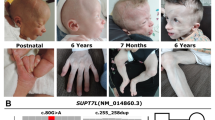Summary
A possible cause of non-disjunction of chromosome 21 in Down Syndromes has been cytogenetically evaluated by examining the parents by Ag-staining technique. In all the cases studied so far, the contributing parents have active ribosomal cistrons on both chromosomes 21 i.e. both chromosomes are stained positively by silver staining. These results show that the active NORs might play an essential role in meiotic non-disjunction. Furthermore, the preliminary results demonstrate that the acrocentric associations of homologous and non-homologous nature involving chromosome 21 are the most frequent in the contributing parent which may further indicate the role of multiple cellular factors affecting the associations in promoting the non-disjunction in addition to active NORs. The possible mechanisms regarding the non-disjunction of chromosome 21 have been described.
Similar content being viewed by others
References
Alfi SO, Chang R, Azen PS (1980) Evidence for genetic control of nondisjunction in man. Am J Hum Genet 32:477–483
Antonarakis SE, Kittur SD, Metaxotou C, Watkins PC, Patel AS (1985) Analysis of DNA haplotypes suggests genetic predisposition to trisomy 21 associated with DNA sequences on chromosome 21. Proc Natl Acad Sci USA 82:3360–3364
Babu KA, Verma RS (1985) Structural and functional aspects of nucleolar organizer regions (NORs) or human chromosomes. Int Rev Cytol 94:151–176
de la Cruz FF, Gerald PS (1981) Trisomy 21 (Down Syndromes) research prospective. University Park Press. Baltimore
Holmes BL (1978) Genetic counseling for the older pregnant women: new Data and questions. N Engl J Med 298:1419–1921
Juberg RC, Mowery PN (1983) Origin of nondisjunction in trisomy 21 syndrome: all studies compiled, parental age analysis, and international comparisons. Am J Med Genet 16:111–116
Ved Brat S, Verma RS, Dosik H (1979) A simplified technique for simultaneous staining of nucleolar organizer regions (NORs) and kinetochore. Stain Techol 54:107–109
Verma RS, Dosik H (1976) An improved method of photographing human fluorescent chromosomes. J Micros 108:339–341
Verma RS, Dosik H (1978) Trisomy 21 in a child due to paternal nondisjunction as determined by RFA technique. Jpn J Hum Genet 23:17–21
Verma RS, Dosik H (1980) Human chromosomal heteromorphisms. Nature and clinical significance. Int Rev Cytol 62:361–381
Verma RS, Lubs HA (1975a) A simple R-banding technic. Am J Hum Genet 27:110–117
Verma RS, Lubs HA (1975b) Variation in human acrocentric chromosomes with acridine orange reverse banding. Hum Genet 30:225–235
Verma RS, Dosik H, Lubs HA (1977) Demonstration of color and size polymorphisms in human acrocentric chromosomes by acridine orange reverse banding. J Hered 68:262–263
Verma RS, Benjamin C, Rodriguez J, Dosik H (1981) Population heteromorphisms of Ag-stained nucleolus organizer regions (NORs) in the acrocentric chromosomes of East Indians. Hum Genet 59:412–415
Verma RS, Huq A, Madahar C, Qazi Q, Dosik H (1982a) Higher incidence of small Y chromosome in humans with trisomy 21 (Down Syndrome). Pediatr Res 16:769–770
Verma RS, Shah JV, Dosik H (1982b) Orientation of nucleolar organizer chromosomes at somatic metaphases with respect to silver staining. Genetics 100:s 71
Verma RS, Shah JV, Dosik H (1983a) Frequencies of chromosome and chromatid types of associations of nucleolar human chromosomes demonstrated by the N-banding technique. Cytobios 36:25–29
Verma RS, Rodriguez J, Shah JV, Dosik H (1983b) Preferential association of nucleolar organizing human chromosomes as revealed by silver staining technique at mitosis. Mol Gen Genet 190:352–354
Verma RS, Chemitiganti S, Dosik H (1983c) Origin of aneuploid chromosome 21 in Down Syndrome. Genetics 104:s 70
Author information
Authors and Affiliations
Additional information
Communicated by R. Illmensee
Rights and permissions
About this article
Cite this article
Verma, R.S., Babu, A., Chemitiganti, S. et al. A possible cause of non-disjunction of additional chromosome 21 in Down syndrome. Molec Gen Genet 202, 339–341 (1986). https://doi.org/10.1007/BF00333259
Received:
Issue Date:
DOI: https://doi.org/10.1007/BF00333259




